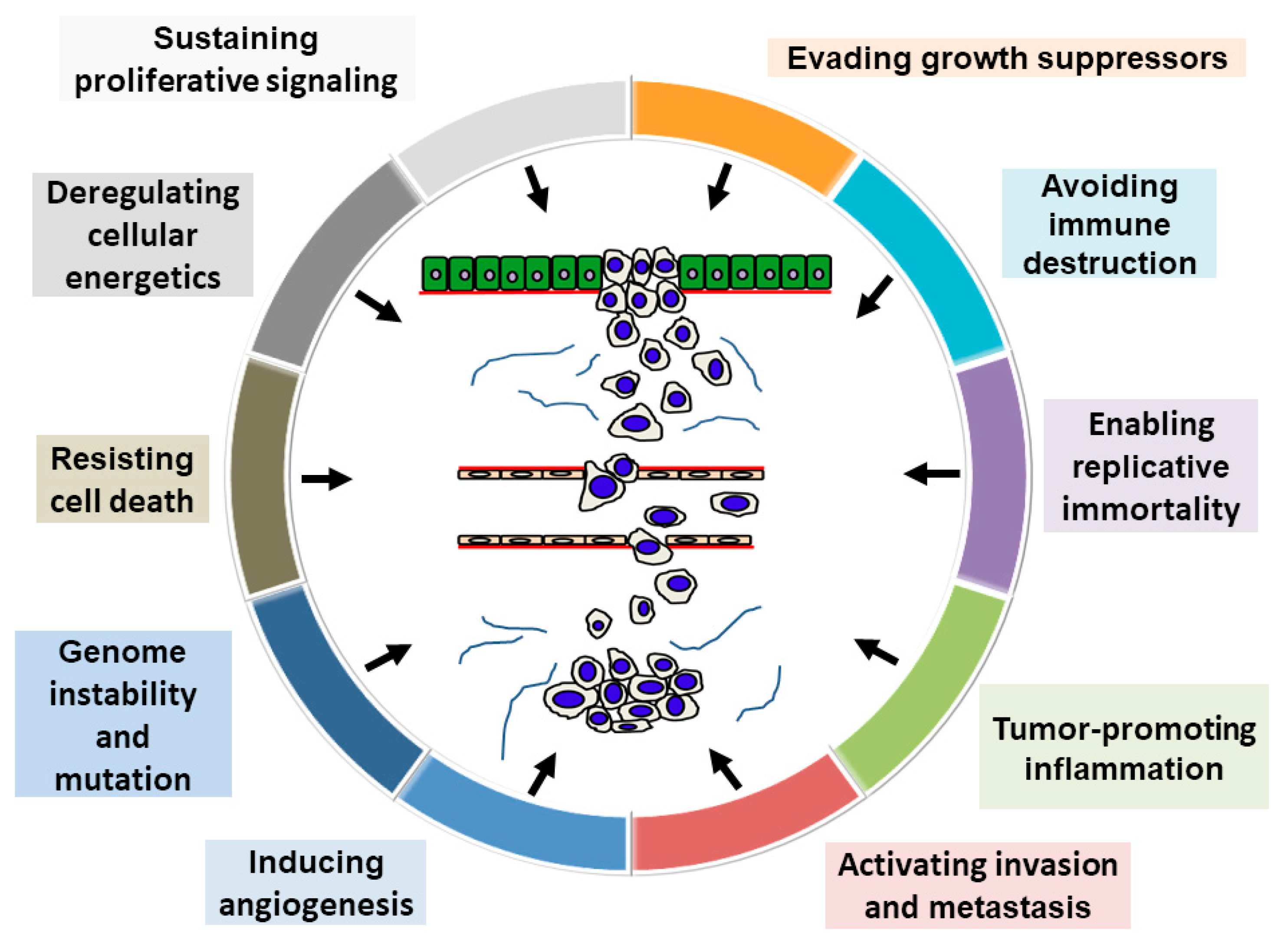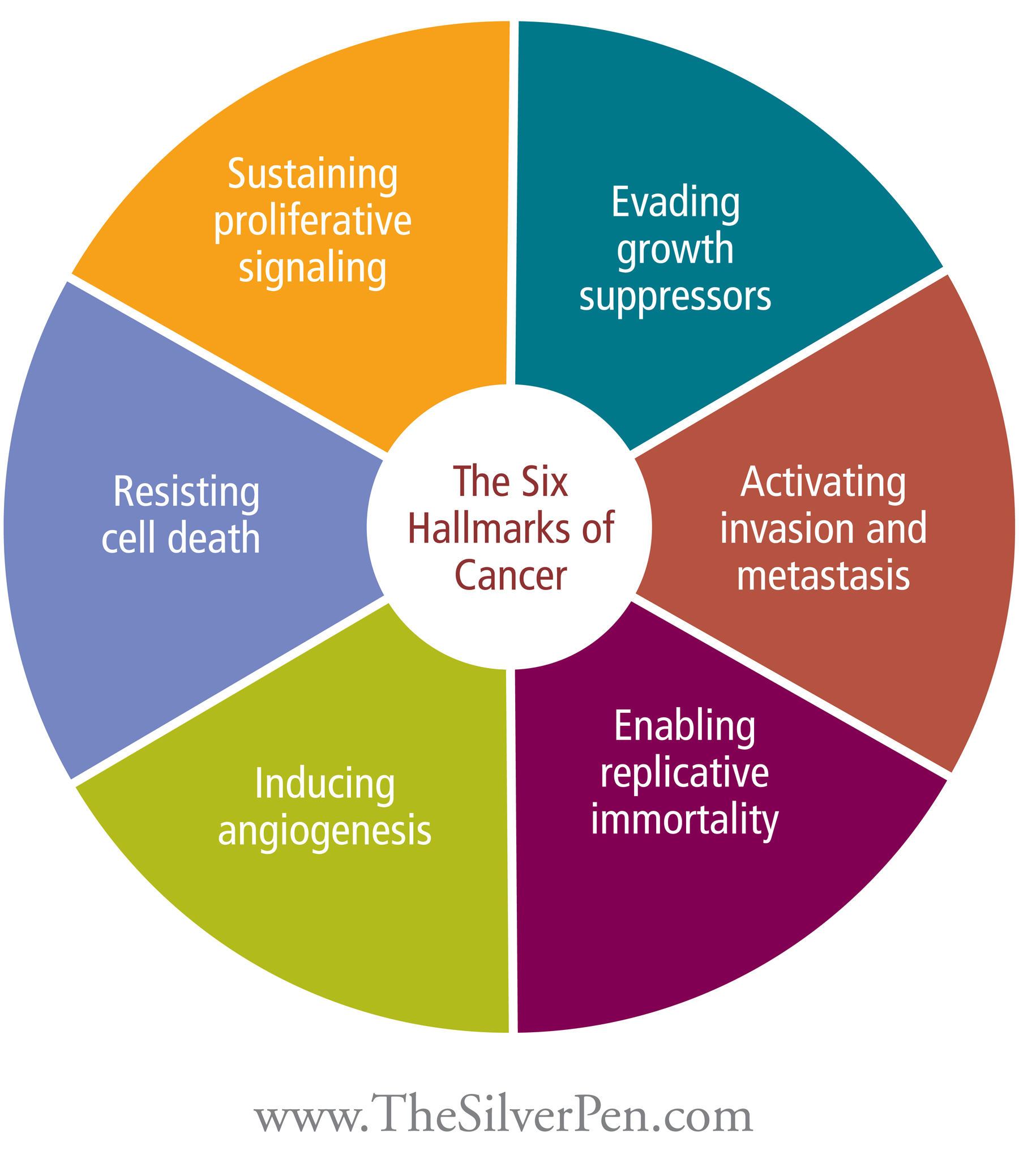The idea of cancer hallmarks was first proposed by Hanahan and Weinberg in a seminal paper in 2000 and an expanded and updated version in 2011 D. A Population Based Study.
Hallmarks Of Cancer Hanahan And Weinberg 2000. The hallmarks of cancer comprise six biological capabilities acquired during the multistep development of human tumors. They described six capabilities acquired during tumourigenesis and tumour developmentsustaining. An Emphasis on Orthopaedics. Specifically they proposed that the many complex mutations and heritable changes could in fact be organised into a limited number of.
 3 Six Hallmark Capabilities Proposed By Hanahan And Weinberg In 2000 To Download Scientific Diagram From researchgate.net
3 Six Hallmark Capabilities Proposed By Hanahan And Weinberg In 2000 To Download Scientific Diagram From researchgate.net
In 2000 Hanahan and Weinberg published a landmark paper on the Hallmarks of Cancer in the prestigious journal Cell D. We have proposed that six hallmarks of cancer together constitute an organizing principle that provides a logical framework for understanding the remarkable diversity of neoplastic diseases Hanahan and Weinberg 2000. Implicit in our discussion was the notion that as normal cells evolve progressively to a neoplastic state they acquire a succession of these. In 2000 Douglas Hanahan shown below and Robert Weinberg published a paper in Cell The Hallmarks of Cancer which identified some organizing principles of cancer cell development. The hallmarks of cancer. Dissecting the underlying events driving the genesis and progression of cancer remains a major challenge for researchers and clinicians.
The hallmarks constitute an organizing principle for rationalizing the complexities of neoplastic disease.
It was an ambitious. 57-70 This article summarized a quarter of a century of research that viewed cancer as a disease involving the dynamic changes in the genome. The eight distinct hallmarks consist of sustaining proliferative signaling evading growth suppressors resisting cell death enabling replicative immortality inducing angiogenesis activating invasion and metastasis deregulating cellular energetics and metabolism and avoiding immune destruction. The hallmarks of cancer.
 Source: mdpi.com
Source: mdpi.com
 Source: healio.com
Source: healio.com
 Source: cisncancer.org
Source: cisncancer.org
 Source: slidetodoc.com
Source: slidetodoc.com
100 5770 January 7 2000 Copyright 2000 by Cell Press The Hallmarks of Cancer Review Douglas Hanahan and Robert A. The hallmarks of cancer. In 2000 Douglas Hanahan shown below and Robert Weinberg published a paper in Cell The Hallmarks of Cancer which identified some organizing principles of cancer cell development. The process of tumorigenesis is complex and results from the evolution of different hallmarks of cancer. Weinberg Department of Biochemistry and Biophysics and Hormone Research Institute University of California at San Francisco San Francisco California 94143 Whitehead Institute for Biomedical Research and.
 Source: researchgate.net
Source: researchgate.net
2000 The Hallmarks of Cancer Cell Vol. They described six capabilities acquired during tumourigenesis and tumour developmentsustaining. The idea of cancer hallmarks was first proposed by Hanahan and Weinberg in a seminal paper in 2000 and an expanded and updated version in 2011 D. The conceptualization involves eight acquired capabilitiesthe. The hallmarks constitute an organizing principle for rationalizing the complexities of neoplastic disease.
 Source: researchgate.net
Source: researchgate.net
D Hanahan 1 R A Weinberg. The idea of cancer hallmarks was first proposed by Hanahan and Weinberg in a seminal paper in 2000 and an expanded and updated version in 2011 D. The conceptualization involves eight acquired capabilitiesthe. Hanahan D and Weinberg RA 2000 The hall marks of cancer. 57-70 This article summarized a quarter of a century of research that viewed cancer as a disease involving the dynamic changes in the genome.

1Department of Biochemistry Hormone Research Institute University of California at. 57-70 This article summarized a quarter of a century of research that viewed cancer as a disease involving the dynamic changes in the genome. We have proposed that six hallmarks of cancer together constitute an organizing principle that provides a logical framework for understanding the remarkable diversity of neoplastic diseases Hanahan and Weinberg 2000. In 2000 Hanahan and Weinberg suggested a comprehensive logical framework for the functional study of cancer. The article appeared in the Millennium issue of the journal Cell and it went on to influence a generation of cancer researchers.
 Source: researchgate.net
Source: researchgate.net
100 5770 January 7 2000 Copyright 2000 by Cell Press The Hallmarks of Cancer Review Douglas Hanahan and Robert A. 2000 The Hallmarks of Cancer. Hanahan and Weinberg Douglas Hanahan and Weinberg. Both classes of cancer genes have been identified through their alteration in human and animal cancer cells and by their elicitation of cancer phenotypes in experimental models Bishop and Weinberg 1996. â The nature of the replication machinery is that chromosomes get smaller every time they divide.
 Source: researchgate.net
Source: researchgate.net
Dissecting the underlying events driving the genesis and progression of cancer remains a major challenge for researchers and clinicians. Weinberg Department of Biochemistry and Biophysics and Hormone Research Institute University of California at San Francisco San Francisco California 94143 Whitehead Institute for Biomedical Research and. 2000 The Hallmarks of Cancer. 2000 The Hallmarks of Cancer Cell Vol. In 2000 Douglas Hanahan shown below and Robert Weinberg published a paper in Cell The Hallmarks of Cancer which identified some organizing principles of cancer cell development.
 Source: researchgate.net
Source: researchgate.net
D Hanahan 1 R A Weinberg. Volcanos mouth Weinberg and Hanahan published an article The. Weinberg Department of Biochemistry and Biophysics and Hormone Research Institute University of California at San Francisco San Francisco California 94143 Whitehead Institute for Biomedical Research and. The article appeared in the Millennium issue of the journal Cell and it went on to influence a generation of cancer researchers. In 2000 Hanahan and Weinberg published a landmark paper on the Hallmarks of Cancer in the prestigious journal Cell D.
 Source: researchgate.net
Source: researchgate.net
Hallmarks of Cancer to summarize these rules. The hallmarks constitute an organizing principle for rationalizing the complexities of neoplastic disease. They described six capabilities acquired during tumourigenesis and tumour developmentsustaining. 57-70 This article summarized a quarter of a century of research that viewed cancer as a disease involving the dynamic changes in the genome. 2000 The Hallmarks of Cancer.

Specifically they proposed that the many complex mutations and heritable changes could in fact be organised into a limited number of. In 2000 Hanahan and Weinberg published a landmark paper on the Hallmarks of Cancer in the prestigious journal Cell D. The hallmarks constitute an organizing principle for rationalizing the complexities of neoplastic disease. Hanahan D and Weinberg RA 2000 The hall marks of cancer. In 2000 Hanahan and Weinberg published an article and they claimed that malignant cells in all types of cancers share six traits that allow normal cells to become cancerous ones namely sustaining proliferative signaling evading growth suppressors avoiding immune destruction enabling replicative immortality tumor-promoting inflammation.

Dissecting the underlying events driving the genesis and progression of cancer remains a major challenge for researchers and clinicians. 2000 The Hallmarks of Cancer. Weinberg Department of Biochemistry and Biophysics and Hormone Research Institute University of California at San Francisco San Francisco California 94143 Whitehead Institute for Biomedical Research and. Hanahan and Weinberg presented in 2000 and 2011 seminal contributions in the cancer field first the six hallmarks of cancer and a decade later two additional hallmarks and two enabling characteristics were added. â The nature of the replication machinery is that chromosomes get smaller every time they divide.
 Source: abcam.com
Source: abcam.com
And iconic work that marked a return after nearly a. Hanahan and Weinberg Douglas Hanahan and Weinberg. The hallmarks of cancer comprise six biological capabilities acquired during the multistep development of human tumors. 2000 The Hallmarks of Cancer. A major challenge for cancer medicine involves the remarkable variability of the disease at all levels.

Both classes of cancer genes have been identified through their alteration in human and animal cancer cells and by their elicitation of cancer phenotypes in experimental models Bishop and Weinberg 1996. This categorization has helped to conceptualize the essence of cancer and its underlying. And iconic work that marked a return after nearly a. The foundation has been set in the discovery of mutations that produce oncogenes with dominant gain of function and tumor suppressor genes with recessive loss of function. The 5 Hallmarks of Biomaterials Success.
 Source: cisncancer.org
Source: cisncancer.org
100 5770 January 7 2000 Copyright 2000 by Cell Press The Hallmarks of Cancer Review Douglas Hanahan and Robert A. 2000 The Hallmarks of Cancer. D Hanahan 1 R A Weinberg. The hallmarks of cancer. Both classes of cancer genes have been identified through their alteration in human and animal cancer cells and by their elicitation of cancer phenotypes in experimental models Bishop and Weinberg 1996.
 Source: hep.ucl.ac.uk
Source: hep.ucl.ac.uk
Both classes of cancer genes have been identified through their alteration in human and animal cancer cells and by their elicitation of cancer phenotypes in experimental models Bishop and Weinberg 1996. Hanahan D and Weinberg RA 2000 The hall marks of cancer. Hallmarks of Cancer to summarize these rules. The process of tumorigenesis is complex and results from the evolution of different hallmarks of cancer. Specifically they proposed that the many complex mutations and heritable changes could in fact be organised into a limited number of.
 Source: healio.com
Source: healio.com
2000 The Hallmarks of Cancer Cell Vol. 2000 The Hallmarks of Cancer Cell Vol. A major challenge for cancer medicine involves the remarkable variability of the disease at all levels. Both classes of cancer genes have been identified through their alteration in human and animal cancer cells and by their elicitation of cancer phenotypes in experimental models Bishop and Weinberg 1996. The hallmarks of cancer constitute an organizing principle that may provide a rational basis for distilling this complexity so as to better understand mechanisms of the disease in its diverse manifestations.





